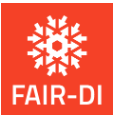Speaker
Description
When gathering your research data and creating a knowledge graph, two aspects are key for achieving high data quality: making your data globally understandable and meaningful by semantic enrichment, and ensuring local conformance and completeness of your data by running validations. There are widely used languages within the Resource Description Framework (RDF) ecosystem to support these tasks, for example OWL to describe ontologies and SHACL to specify validations. However, applying these in your everyday work can be a very tedious and error prone task. Herbie, the hybrid electronic laboratory notebook and research database developed at Hereon, makes this process fast, simple and flexible.
Herbie is a client-server based web application wrapping an RDF triplestore and adding additional functionality on top of it. Its core design principle is to make use of these well-established frameworks in the RDF ecosystem like RDFS, OWL, SHACL, Schema.org, RO-Crate, etc., and give them an accessible and meaningful interface. In particular, we will see how Herbie builds on the SHACL Shapes Constraint Language to let you construct easily (re-)usable web forms helping you to turn your lab journal into a semantically rich knowledge base.
Additional features of Herbie include versioning of RDF graphs as well as managing access restrictions. Users can interact with Herbie using the graphical web interface or via its REST API to create, view, update or delete RDF graphs. This makes Herbie a platform for collaborative editing of a shared knowledge graph, applicable in various (research) environments.
